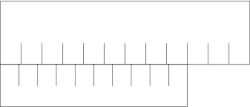Vernier acuity
Vernier acuity is a type of visual acuity – more precisely of hyperacuity – that measures the ability to discern a disalignment among two line segments or gratings. A subject's vernier (IPA: /ˈvɜːrniər/ or /ˈvɜːniə/) acuity is the smallest visible offset between the stimuli that can be detected. Because the disalignments are often much smaller than the diameter and spacing of retinal receptors, vernier acuity requires neural processing and "pooling" to detect it. Because vernier acuity exceeds acuity by far, the phenomenon has been termed hyperacuity.[1] Vernier acuity develops rapidly during infancy and continues to slowly develop throughout childhood.[2][3] At approximately three to twelve months old, it surpasses grating acuity in foveal vision in humans.[2] However, vernier acuity decreases more quickly than grating acuity in peripheral vision.[4][5] Vernier acuity was first explained by Ewald Hering in 1899,[6] based on earlier data by Alfred Volkmann in 1863[7] and results by Ernst Anton Wülfing in 1892.[8]

Vernier acuity is resistant to defocus, motion, and luminance, but is subject to practice effects and changes in attention.[3] After training, observers' threshold has been shown to improve as much as 6 fold.[9]
Testing
Vernier acuity is measured by asking participants to judge the offset between two parallel line segments with both eyes (binocular vision) or with each eye individually (monocular vision).[10]
Vernier measures in infants and non-verbal children can be done using the preferential-looking technique[11] or by electrophysiologal techniques.[12][3]
References
- Westheimer, Gerald (1975). "Visual acuity and hyperacuity". Investigative Ophthalmology and Visual Science. 14: 570–572.
- Robert H. Duckman (2006). Visual Development, Diagnosis, and Treatment of the Pediatric Patient. Lippincott Williams & Wilkins. pp. 36–48. ISBN 978-0-7817-5288-6.
- Gordon Dutton; Martin Bax (25 October 2010). Visual Impairment in Children due to Damage to the Brain: Clinics in Developmental Medicine. John Wiley & Sons. p. 80. ISBN 978-1-898683-86-5.
- J.R. Brannan (23 January 1992). Applications of Parallel Processing in Vision. Elsevier. p. 95. ISBN 978-0-08-086740-3.
- Strasburger, H.; Rentschler, I.; Jüttner, M. (2011). "Peripheral vision and pattern recognition: a review". Journal of Vision. 11 (5): 1–82. doi:10.1167/11.5.13. PMID 22207654.
- Strasburger, Hans; Huber, Jörg; Rose, David (2018). "Ewald Hering (1899) On the Limits of Visual Acuity: A Translation and Commentary. With a Supplement on Alfred Volkmann (1863) Physiological Investigations in the Field of Optics". I-Perception. 9 (3): 204166951876367. doi:10.1177/2041669518763675. PMC 5990881. PMID 29899967.
- Strasburger, Hans; Rose, David (2018). "Alfred Volkmann (1863). Physiological Investigations in the Field of Optics (Physiologische Untersuchungen im Gebiete der Optik). Partial translation and Commentary; Supplement to Strasburger, H.; Huber, J.; Rose, D. (2018). "Ewald Hering (1899) On the Limits of Visual Acuity". I-Perception. 9 (3): 204166951876367. doi:10.1177/2041669518763675. PMC 5990881. PMID 29899967.
- Wülfing, Ernst Anton (1892). "Ueber den kleinsten Gesichtswinkel [On the smallest visual angle]". Zeitschrift für Biologie, Neue Folge. 11: 199–202.
- Westheimer G, McKee SP (1978). "Stereoscopic acuity for moving retinal images". Journal of the Optical Society of America. 68 (4): 450–455. doi:10.1364/JOSA.68.000450.
- Ian P. Howard Center for Vision Research York University; Brian J. Rogers Department of Experimental Psychology Oxford University (30 November 1995). Binocular Vision and Stereopsis. Oxford University Press. p. 180. ISBN 978-0-19-802461-3.
- Shimojo, S.; Birch, E.E.; Gwiazda, J.; Held, R. (1984). "Development of vernier acuity in infants". Vision Research. 24 (7): 721–728. doi:10.1016/0042-6989(84)90213-x.
- Norcia, A.M.; Wesemann, W.; Manny, R.E. (1999). "Electrophysiological correlates of vernier and relative motion mechanisms in human visual cortex". Visual Neuroscience. 16 (5): 1123–1131.